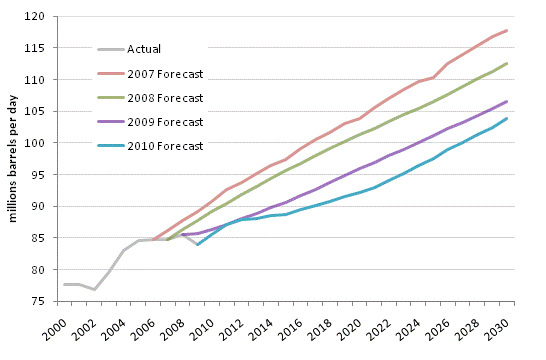This is a guest post from Steven Kopits. Steven heads the New York office of Douglas-Westwood, energy business consultants.
- TOD editor Gail Tverberg
The EIA, the statistics arm of the US Department of Energy, recently released its International Energy Outlook (IEO) for 2010. This is an important document for forecasters, as it represents the EIA's integrated view of the global energy markets in the years to come and contains a long term forecast on the range of energy sources and CO2. Like it or hate it, the IEO is a touchstone for the energy industry and is treated as the authoritative government forecast in the press and in capital raising documents like prospectuses. It influences policy-makers, the media, public opinion and investors. What it says matters.
And what does it say?
That peak oil is all but on us. And that's new.
As recently as 2007, the EIA saw a rosy future of oil supplies increasing with demand. It predicted oil consumption would rise by 15 million barrels per day (mbpd) to 2020, an ample amount to cover most eventualities. By 2030, the oil supply would reach nearly 118 mbpd, or 23 mbpd more than in 2006. But over time, this optimism has faded, with each succeeding year's forecast lower than the year before. For 2030, the oil supply forecast has declined by 14 mbpd in only the last three years. This drop is as much as the combined output of Saudi Arabia and China.

EIA Forecasts of World Petroleum Liquids Production to 2030
Source: EIA IEO - 2007-2010
But that's not the interesting part. The more salient development is the reduction in the forecast to 2020. Forecasts beyond ten years are highly uncertain and more subject to massaging and 'interpretation'. Shorter term forecasts are more definite, and the forecasters are more accountable. As a consequence, the outlook for the short to medium term warrants greater attention. In the case of the EIA, the forecast changes most dramatically here.
For the remainder of the decade, even though China would be expected to hit its stride for increased oil demand, the EIA sees no year in which liquids production will increase by even 1%. Petroleum liquids supply increases by an average of 0.6% per year from 2011 to 2020. In other words, the EIA is expecting the oil supply to be essentially flat for the rest of the decade. The supply will creep up from 86 mbpd today to approximately 92 mbpd to 2020, but that is not much growth, and indeed, is about the same as current global liquids production capacity. Moreover, it represents a reduction of nearly 4 mbpd from last year's forecast for 2020. On paper, the output of China has disappeared over the course of the last year.
In its forecast, the EIA, normally the cheerleader for production growth, has become amongst the most pessimistic forecasters around. For example, its forecasts to 2020 are 2-3 mbpd lower than that of traditionally dour Total, the French oil major. And they are below our own forecasts at Douglas-Westwood through 2020. As we are normally considered to be in the peak oil camp, the EIA's forecast is nothing short of remarkable, and grim.
Is it right? In the last decade or so, the EIA's forecast has inevitably proved too rosy by a margin. While SEC-approved prospectuses still routinely cite the EIA, those who deal with oil forecasts on a daily basis have come to discount the EIA as simply unreliable and inappropriate as a basis for investments or decision-making. But the EIA appears to have drawn a line in the sand with its new IEO and placed its fortunes firmly with the peak oil crowd. At least to 2020.
We'll see how it plays out. But for now, the EIA appears to be making a statement. Perhaps we should sit up and pay attention.
Another wake-up call for the world’s biggest oil junkieBridgestone has profit of $191M
No comments:
Post a Comment